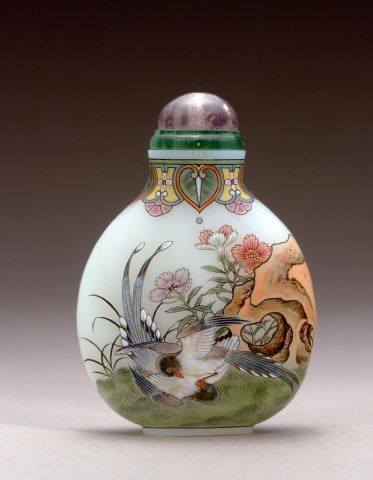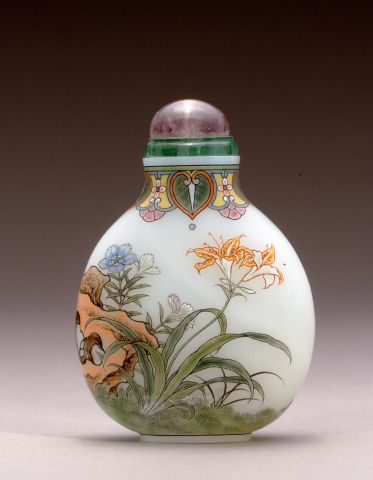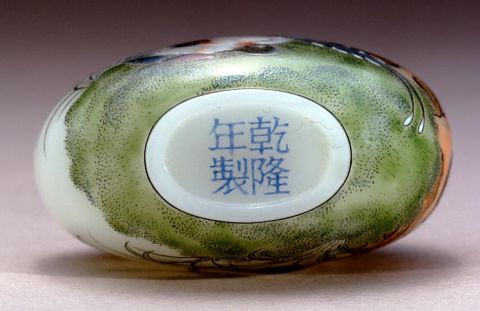


Bottle ID: 00372
WANG XISAN, WHITE, TUMBLING BIRDS & GARDEN LANDSCAPE
Date: 1962-1965
Height: 52 mm
Glass, of rounded form with the shoulders tapering to a slightly everted lip, and with a neatly carved footrim; decorated in famille rose enamels on a milk-white ground with a continuous scene of a pair of cavorting ribbon-tailed birds on the grass beside convoluted rocks from which flowers and grasses issue; below a band at the neck of leaves and flowerheads; the base with a blue enamel Qianlong nianzhi mark.
Attributed to Wang Xisan.
Similar Examples:
Crane Collection nos. 148, 386, 647 and 904.
Stevens, Bob C. The Collector's Book of Snuff Bottles, 1976, p. 266, no. 954.
Moss, Hugh, Victor Graham, and Ka Bo Tsang. The Art of the Chinese Snuff Bottle - The J & J Collection, 1993, Vol. I, p. 340, no. 198.
Kleiner, Robert. Treasures from the Sanctum of Enlightened Respect,
Chinese Snuff Bottles from the Collection of Denis Low, 1999, p. 33, no. 24.
Low, Denis S. K. More Treasures from the Sanctum of Enlightened Respect,
2002, p. 29, no. 26.
Sotheby's, New York, September 14, 2010, lot 120, The Joe Grimberg Collection.
Provenance:
Hugh Moss [HK] Ltd.
Margaret Prescott Wise and Edgar Wise
Edward Soong, August 26th, 1968
Exhibited:
Annual Convention ICSBS Toronto, October 2007
Published:
JICSBS, Winter 2008, figs. 19a and 19b
Wang Xisan was taught the art of enameling by Ye Bengqi, along with the art of painting inside bottles. He used the same technique of enameling as Ye, first sketching the outline in black enamel and then applying layers of thinly colored enamels to build up levels of strong, vivid color. This bottle is one of the finest of Wang's enamel bottles executed at the height of his enameling career. The subject matter of tumbling birds is unusual both for Wang Xisan and Ye Bengqi, as Ye had passed on to Wang a more typical style of bird and flower painting. While Ye Bengqi copied mainly Palace originals, he also appeared to favor the Guyue Xuan style and this is evident in the tradition he passed to Wang Xisan. Wang did not produce a large number of enamel snuff bottles as he began to focus on the One Bottle Studio and became a teacher himself. His working period for enamels spanned a short period of time from 1962-1965.
The symbolism on this bottle relates to the family. One of the flowers on this bottle is the day lily, which together with rockwork, are symbols of longevity. Together they form a rebus: "May you have sons and live long". The pair of ribbon-tailed birds stand for husband and wife and symbolize longevity in marriage.
< Back to full list

 English
English 中文
中文